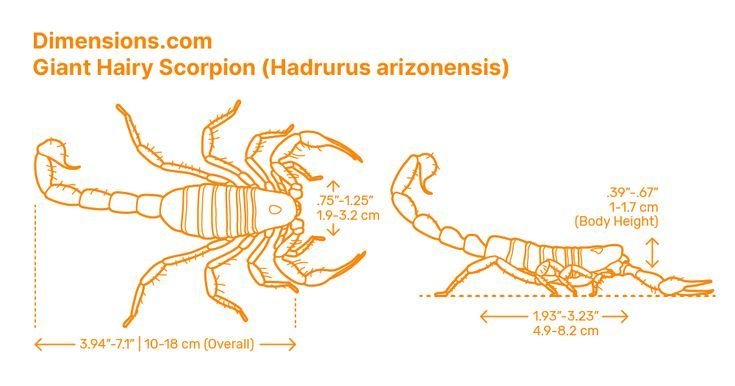
Scorpions are a diverse group of arachnids, with around 1,500 species worldwide. They range from the tiny ones that could easily hide under a leaf to the intimidating ones that can grow over 8 inches long. The giant hairy scorpion, specifically known as *Hadrurus arizonensis*, is one of the largest and most recognizable. In this article, we’ll explore what makes the giant hairy scorpion unique and how it differs from other species in the scorpion family.
What Is a Giant Hairy Scorpion?
The giant hairy scorpion is native to the deserts of North America, particularly in Arizona and surrounding areas. This species can be quite the eye-catcher, measuring up to 7 inches long and boasting a fuzzy, hairy exoskeleton that gives it a unique look. The hair isn’t just for show, though—it helps these scorpions sense vibrations in their environment, much like a cat’s whiskers.
In terms of coloration, the giant hairy scorpion is generally a mix of beige and brown, providing excellent camouflage against the sandy desert landscape. It’s a nocturnal creature, meaning it comes alive at night when temperatures drop. If you ever encounter one on a desert walk, it may surprise you with its surprisingly quick movements!
Physical Characteristics
When comparing the giant hairy scorpion to other species, its sheer size is the most obvious difference. Most common scorpions, like the bark scorpion (*Centruroides sculpturatus*), are generally smaller, measuring around 3 to 4 inches. Here’s a closer look at some key physical traits:
- Size: The giant hairy scorpion can reach up to 8 inches long, while others stick to about 3-4 inches.
- Appearance: Its hairy texture is unlike the smooth bodies of many other scorpions, like the Texas or yellow scorpions.
- Tail and Claws: This species has thick pincers and a long, slender tail that ends in a stinger, similar to others, but the size difference is notable.
The size and hair of the giant hairy scorpion make it impressive, but they also impact how it interacts with its environment. For instance, larger pincers allow it to grasp prey more easily, while the long tail is used for defense and hunting.
Habitat and Distribution
Giant hairy scorpions thrive in specific environments that differ from those preferred by other species. While many scorpions can adapt to various habitats, the giant hairy scorpion sticks mainly to dry and rocky desert areas.
You might find them hiding under rocks, in crevices, or even burrowing in the sandy ground during the hot daytime. Other species, like the bark scorpion, prefer more humid environments, often taking refuge in trees or buildings.
This preference for dry habitats also influences their diet and hunting methods. The giant hairy scorpion is a skilled ambush predator, waiting patiently for small insects to pass by, while other species might actively chase their meals.
Behavior and Diet
The behavior of the giant hairy scorpion sets it apart from smaller species. This scorpion is primarily a solitary creature, often preferring to stake out its territory alone. Unlike social insects, such as bees, scorpions tend to be more like introverts at a party—keeping to themselves until they’re hungry.
Their diet mainly consists of insects and small arthropods. The giant hairy scorpion uses its big claws to seize prey, while other smaller scorpions might rely more on speed or venom to catch food. Interestingly, the giant hairy scorpion is also known to eat smaller scorpions, showing a more aggressive side when food is scarce.
Venom and Defense Mechanisms
When it comes to venom, giant hairy scorpions are often misunderstood. Despite their intimidating appearance, their venom is relatively mild compared to that of smaller species like the bark scorpion. For instance, a bark scorpion’s sting can be excruciatingly painful and potentially dangerous, especially to small children or pets.
Strong pincers serve as the primary defense mechanism for giant hairy scorpions. They rely on their size and strength to deter predators, unlike smaller species that might rely more heavily on their venom. If threatened, a giant hairy scorpion will sometimes just raise its pincers and show off its size, rather than attack.
Life Cycle and Reproduction
The reproductive habits of the giant hairy scorpion differ from those of other scorpion species. They have a fascinating courtship process that involves a kind of dance. Males will grab the females and guide them in a circular motion to find a suitable place to mate. This is a delicate process since, in some species, the female may hunt and eat the male after mating!
After a gestation period of several months, the female gives birth to live young, which is called being ovoviviparous. This is different from many insects that lay eggs. The tiny scorpions are born with their mother but quickly climb onto her back for protection until they shed their first exoskeleton.
The giant hairy scorpion certainly stands out among its relatives, boasting unique physical traits, behaviors, and habitats. Understanding these differences helps us appreciate the complexity of the scorpion family and the roles each species plays in its ecosystem.
So, if you ever find yourself in the desert and spot this impressive creature, give it some respect! It’s much more than just a big, hairy arachnid; it’s a survivor that has adapted to its environment in remarkable ways. Whether you’re a scorpion enthusiast or just curious, knowing about the giant hairy scorpion and its counterparts gives you a richer appreciation for the diversity of life on our planet.
